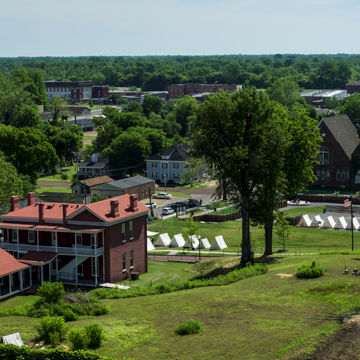Built by Arthur Thompson, a former Phillips County sheriff, the two-story L-shaped house built of red brick is a carefully proportioned blend of Greek Revival and Italianate. The entrance porch is sheltered by a single-story cast-iron porch, with a balcony above, and the entrance door is framed by sidelights and a fanlight. The cornice is bracketed, and the front gable of the ell is outlined as a pediment. Room heights inside rise to eleven feet, and the plasterwork of the ceilings is enriched with rosettes and pierced cornices. In 1877 Thompson sold the house to Robert Caswell Moore, whose descendants gave it to the State of Arkansas in 1995 to be part of the Delta Cultural Center. The house is now used for educational programs and activities. A fire in 1999 destroyed most of the roof, but it was restored, as was the interior. Opposite the house is a nearly full-size replica of the earth and wood Fort Curtis, where one of the bloodiest Civil War battles in Helena took place.
You are here
Moore-Hornor House, Delta Cultural Center
If SAH Archipedia has been useful to you, please consider supporting it.
SAH Archipedia tells the story of the United States through its buildings, landscapes, and cities. This freely available resource empowers the public with authoritative knowledge that deepens their understanding and appreciation of the built environment. But the Society of Architectural Historians, which created SAH Archipedia with University of Virginia Press, needs your support to maintain the high-caliber research, writing, photography, cartography, editing, design, and programming that make SAH Archipedia a trusted online resource available to all who value the history of place, heritage tourism, and learning.





















